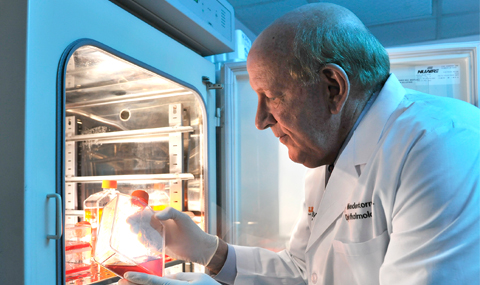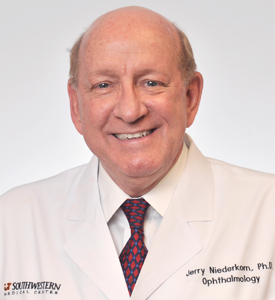Ophthalmologists uncover autoimmune process that causes rejection of secondary corneal transplants
DALLAS – April 16, 2015 – UT Southwestern Medical Center ophthalmologists have identified an important cause of why secondary corneal transplants are rejected at triple the rate of first-time corneal transplants.

The cornea − the most frequently transplanted solid tissue − has a first-time transplantation success rate of about 90 percent. But second corneal transplants undergo a rejection rate three times that of first transplants.
“Understanding why these rejections occur is important to further improving the ways in which corneal transplants are performed,” said the study’s senior author Dr. Jerry Niederkorn, Professor and Vice Chair of Research of Ophthalmology, and Professor of Microbiology. “In the future, ophthalmologists may be able to implement processes, and eventually prescribe medications, that can lower the rates of rejection.”
More than 40,000 transplants are performed annually to replace the cornea, the clear outer lens at the front of the eye, with tissue from a donor. Most corneal transplants are done to correct severe visual impairments caused by keratoconus, a condition in which the normally dome-shaped cornea progressively thins and becomes cone-shaped, according to the American Academy of Ophthalmology.
The high success rate of first-time corneal transplants is attributed to a process called immune privilege, which allows transplants to be successfully performed without matching the donor tissue to that of the recipient, as is required for organ transplants.

Although immune privilege accounts for the initial high success rate, it can occasionally fail, leading to the rejection of corneal transplants in approximately 10 percent of patients. In patients requiring a second transplant, the incidence of immune rejection rises to almost 70 percent.
“We believe that this loss of immune privilege is similar to an alarm that signals the immune system of potential infection, which results in a full blown immune response at the expense of the corneal transplant,” said Dr. Niederkorn, who holds the Royal C. Miller Chair in Age-Related Macular Degeneration Research and the George A. and Nancy P. Shutt Professorship in Medical Science.
Researchers studying mouse models discovered that after the first corneal transplant is accepted, T regulatory cells prevent other types of immune cells from attacking and rejecting the transplant.
But severing corneal nerves, which occurs during the first transplantation procedure, releases high levels of the neuropeptide Substance P. The resulting high Substance P levels disable the T regulatory cells needed for acceptance of subsequent corneal transplants. This inactivation results in rejection of more than 90 percent of the second corneal transplants in mice and helps to explain the curiously high risk for corneal graft rejection in patients who receive a second corneal transplant.
Researchers found that the high Substance P levels can be blocked with drugs to restore the eye’s immune privilege and promote the acceptance of second corneal transplants.
The study, which appears in the American Journal of Transplantation, is supported by grants EY007641 and EY020799 from the National Institutes of Health and Research to Prevent Blindness.
Future research will focus on pharmacological strategies for restoring T regulatory cell function and promoting the survival of second corneal transplants. Other studies will determine if these findings can be extended to enhancing the immune response to cancers.
Researchers involved in this study included first author Dr. Kathryn J. Paunicka, former graduate student in Dr. Niederkorn’s lab, and current postdoctoral research fellow at Stanford University School of Medicine; Dr. Matthew Petroll, Professor of Ophthalmology; Dr. Danielle Robertson, Assistant Professor of Ophthalmology; Jessamee Mellon, senior research scientist; and Joseph R. Brown, research associate.
The Niederkorn Lab in UT Southwestern’s Department of Ophthalmology studies the immunobiology of the eye with a specific focus on clinically relevant research that examines corneal transplants. The UT Southwestern Transplant Services Center is a community-based, not-for-profit eye and tissue bank that provides donor recovery and allograft distribution services to the North Texas area. For information on donating, call 1-800-433-6667.
About UT Southwestern Medical Center
UT Southwestern, one of the premier academic medical centers in the nation, integrates pioneering biomedical research with exceptional clinical care and education. The institution’s faculty includes many distinguished members, including six who have been awarded Nobel Prizes since 1985. Numbering approximately 2,800, the faculty is responsible for groundbreaking medical advances and is committed to translating science-driven research quickly to new clinical treatments. UT Southwestern physicians provide medical care in 40 specialties to about 92,000 hospitalized patients and oversee approximately 2.1 million outpatient visits a year.
###
Media Contact: Remekca Owens
214-648-3404
remekca.owens@utsouthwestern.edu
To automatically receive news releases from UT Southwestern via email, subscribe at www.utsouthwestern.edu/receivenews




